Geochemical constraints on the tectonic setting of the Sonakhan Greenstone Belt,Bastar Craton,Central India
S.D.Deshmukh•K.R.Hari•P.Diwan•M.P.Manu Prasanth
1 Introduction
The nature of petrogenetic and geodynamic processbehind the generation of Archean continental crust still remains one of the most challenging problems in Earth Science(Hawkesworth et al.2010;Foley et al.2002;Rapp et al.2003;Xiao and Santosh 2014;Zhai 2014).Occurrence of Greenstone-Gneiss association is a common feature of Archean cratons(Naqvi2005).Theterm Greenstone Belt is generally used to describe elongated to variably-shaped terrain of variable length and width,consisting of spatially and temporally related materials from(1)Archean to Proterozoic intrusive and extrusive ultramafic,(2)mafic to felsic rocks commonly associated with variable amounts and types of metasedimentary rocks,and(3)intruded by granitoid plutons.85%of the ophiolite occurrences in the greenstone sequences can be classified as the subductionrelated tectonic environment.Subduction unrelated greenstone occurrencesare mainly developed during ocean basin evolution,and are related to continental rifting,seafloor spreading drift-rift tectonics and plume magmatism(Furnes et al.2014,2015).
The Peninsular Indian Shield,which is made up of low to high-grade metamorphic terrain,has an age range of 3.6–2.6 Ga.These terrain attained tectonic stability for prolonged periods,and they constitute continental crust designated as cratons(Naqvi and Rogers 1987;Balasubramanyan 2006;Ramakrishnan and Vaidyanadhan 2008).Stabilization of a craton occurs when intruded by plutons,and as a result,the whole-rock isotopic systems become closed so platform sedimentation takes place on the newly formed basement(Rogers and Santosh 2003).The Bastar Craton,which is located in the eastern part of Peninsular India,is bordered by the Satpura mobile belt in the north,the Pranhita–Godavari rift in the south,the Deccan Traps in thewest,the Eastern ghatsmobilebelt in theeast and the Mahanadi rift in the north east(Ramchandra et al.2001;Ramakrishnan and Vaidyanadhan 2008).
The prominent Greenstone Belts of Peninsular India can be classified into the Keewatin-type and the Dharwar type(Radhakrishna 1976).The Keewatin-type(which includes Hutti-Maski,Sandur,Ramgiri and Kolar belts)can be comparable with other Archaean Greenstone Belts of the world;the Dharwar-type(which includes Bababudan,Chitradurga–Gadag,and Dharwar–Shimoga belts),on the other hand,are akin to the Proterozoic belts of a basinal and geosynclinal type(Radhakrishna and Ramakrishnan 1988,1990).The Sonakhan Greenstone Belt(SGB),located in the Northeastern part of Bastar Craton belongsto the Keewatin type.SGB coversan area of about 1200 km2and represents a late Archaean volcano-sedimentary sequence with mafic and felsic metavolcanic rocks along with Banded Iron Formation,comprised of sedimentary sequences of conglomerate,greywacke,argilliteand ferruginouschert(Arjuni Formation)(Deshmukh et al.2006,2008;Ramchandra et al.2001;Yedekar et al.1990;2003).In the present work,major and trace element geochemical characteristics of metabasalts from SGB are evaluated to elucidate the tectonic setting of the terrain.
2 General geology of the Sonakhan Greenstone Belt
The SGB,with NW–SE trend,is almost perpendicular to the NE-SW trending Central Indian Tectonic Zone CITZ(Fig.1).Based on the Rb–Sr data on meta rhyolites of SGB,Ghosh et al.(1995)proposed that the Sonkhan greenstone terrain formed around 2.5 Ga.However no detailed geochemical and isotopic studies are available from this terrain.The Baghmara Formation in the Sonakhan Greenstone terrane is a suite mainly composed of mafic metabasalts with subordinate rhyolite and tuffaceous materials.The mafic metavolcanic rocks of Baghmara Formation are represented by pillowed and massive/schistose metabasalts.Ray et al.(2000)and Ray and Rai(2004)reported potential gold mineralization from the SGB.Venkatesh(2001)carried out ore mineralogical studies in this terrane and proposed a mesothermal origin for gold mineralization.Deshmukh et al.(2008)reported komatiitic affinity for the metabasaltsof the SGB and correlated SGB with the Hutti Greenstone Belt of the Dharwar Craton.
3 Petrography
The mineral assemblages exhibited in the metabasalts are as follows:
In metabasalt,the overall abundance of plagioclase phenocrysts ranges from 5%to 15%.The other phenocryst phasesinclude clinopyroxene and amphibole(Fig.2a).The groundmass consists of plagioclase, clinopyroxene,amphibole,magnetite and sporadic apatite.In some sections,flow texture is also perceptible(Fig.2b).Secondary phases in some of the samples include chlorite,epidote,and calcite.
4 Geochemistry
The geochemical analysis was carried out in order to determine the major oxides concentration by X-Ray Fluorescence spectrometry (XRF)Philips-1400 (Holland)instrument.Rare earth elements(REE),high field strength elements(HFSE),large ion lithophile elements(LILE)and transition metals(Ni,Co,Cr,V,and Sc)were analyzed using the ICP-MS technique by ELAN DRC II(Perkin Elmer Sciex Instrument,USA)at the National Geophysical Research Institute,Hyderabad,India.
Deshmukh et al.(2008)reported the major element geochemistry of the mafic rocks of SGB and argued a komatiite affinity for these rocks.In the present paper,we are presenting the trace element data of the same samples presented in Deshmukh et al.(2008).For the convenience of the readers,we are incorporating major element data from Deshmukh et al.(2008)(Table 1)along with the new trace element data.
Traditionally,magmatic rocks are classified on the basis of the Total Alkali-Silica(TAS)diagram either by Le Bas et al.(1986)or by Le Bas and Streckeisen(1991).However,the metamorphism and hydrothermal reactions in the greenstone terrain increases the mobility of Na and K.Therefore,classification of igneous rocks in greenstone terrain on the basis of TAS diagram may not be appropriate.Hence,in order to give aproper nomenclature of the rocks,in the present work,we are using Zr/Ti–Nb/Y diagram(Floyd and Winchester 1975).When the samples were plotted in the Zr/Ti–Nb/Y diagram,it was found that all the plots fall in ‘‘basaltic field’’(Fig.3).
Chondrite-normalized REE pattern of all the rocks are similar(Fig.4)and have a typical flat REE [(La/Lu)n=1–1.5]pattern,which is a characteristic feature of komatiite related rocks.Condie(1989)proposed that the flat REE pattern is a characteristic feature of Archean Greenstone Belts with a komatiitic affinity(TH-1type).Incompatible trace element abundances(Table 1)in comparison to the Primitive mantle suggests that most of the SGB metabasalts are characterised by selective enrichment of Large Ion Lithophile Elements(LILE),such as Rb,Ba,and Sr,and relative depletion of High Field Strength Elements(HFSE)such as Nb,P,Ti,Y,and Yb.The primitive mantle normalized multi-element spider diagram is characterized by pronounced negative Nb and Zr anomalies(Fig.5).The presence of negative Nb anomaly indicates a subduction-related genesis (Pearce 1982). Positive anomalies of Pb and Ta were also observed.Sajona et al.(1996)proposed that the island arc basalts have low Nb content(<2 ppm).The low Nb content in the SGB metabasalts(0.236–2.092 ppm)further substantiates subduction magmatism.

Fig.1 Regional geological map of Sonakhan Greenstone Terrane(after Das et al.1990)

Fig.2 Photomicrographs of meta basalts of Sonakhan Greenstone Belt
5 Discussions
5.1 Elemental mobility
Elemental mobility during post-magmatic alteration and metamorphism is a point of concern in the Archaean volcanic rocks(Polat et al.2002).It has been concluded by various workers(Ludden et al.1982;Rajamaniet al.1985;Xie et al.1993;Arndt 1994;Kröner et al.2013;Polat 2013)that the effects of alteration on HFSE,Ti,Cr,Ni,and REE(except Eu)are relatively insignificant(Pearce and Peate 1995).The element Zr is often used as an alteration index of metamorphosed volcanic rocks(Pearce 2014;Rollinson 1999).The mobility of LILE such as Rb,K,Sr and Ba is well documented in Archaean volcanic rocks(Arndt and Goldstein 1989;Arndt 1994).
A general consensus exists that field,petrographic and geochemical criteria may be applied for the evaluation of alteration sensitivity(mobility or immobility of elements)in volcanic rocks that have experienced submarine hydrothermal alteration and metamorphism.These criteria include the preservation of primary volcanic features such as pillows,uniform inter-element ratios and smooth REE patterns(excepting Ce and Eu)etc.However,submarine alteration and metamorphism might have affected the geochemistry of original volcanic rocksto avariableextent as seen in the thin sections.Therefore,the mobility of elements has to be evaluated prior to their application in petrogenetic modeling.
During hydrothermal processes,some major elements such as Ti,Al,and P are generally immobile,whereas others like Na and Ca are almost always mobile(MacGeehan and MacLean 1980;Mottl 1983).At greenschist facies metamorphic conditions,Si,Ti,Al,Mn,and Premain unchanged,whereas Fe,Mg,Na,and K may be mobilized(Pearce 1982;Rollinson 1993).Usefulnessof major element data is therefore often conditional on unknown factors of metamorphism.Therefore,in the present case,in order to evaluate the effect of metamorphism and hydrothermal alteration,we have to focus on the behavior of the trace elements.The mobility of trace elements in metamorphism can be generalized into two groups.(1)Low field strength(LFS)elements(Cs,Sr,K,Rb,and Ba)are generally mobilized,whereas(2)high field strength(HFS)elements(REE,Sc,Y,Th,Zr,Hf,Ti,Nb,Ta,and P)are relatively immobile(Pearce,1982).Further,Co,Ni,V,and Cr are also considered immobile(Rollinson 1993).The linear trendsare shown with Zr and Hf,because when plotted against Y,they indicate their immobile nature and thuscan be used for petrogenetic modeling(Fig.6a,b).
5.2 Magma generation and modification
The tholeiite sequences with komatiitic affinity in the Archaean Greenstone Belts(TH-1 of Condie 1989)generally exhibit a flat REE pattern.Condie and Harrison(1976)studied the Maric Formation in the Midlands Greenstone Belt of Rhodesia and carried out petrogenetic modeling of TH-1,proposing that it is produced by 30%partial melting of a lherzolite source with olivine,clinopyroxene,orthopyroxene and spinel as residual minerals.Arth and Hanson(1975)proposed that TH-1 tholeiite from northwestern Minnesota was derived by 10–25%partial melting of the mantle.The REE patterns of metabasalts of Baghmara Formation closely resemble those of TH-1 from Minnesota,thus pointing towards a similar mantle-melting pattern.When SGB samples were plotted in the La/Yb versus Dy/Yb diagram,they fall in the stability field of spinel peridotite(Fig.7).Modeling of the samples of SGB was carried out using non-modal batch melting process(Baker et al.1997)with La/Yb ratio.The modeling was carried out considering the sample withlowest REE values(SK-6),and the results revealed these rocks were generated by~20%partial melting of a spinel lherzolite(Fig.8).

Table 1 Major and trace element concentrations of mafic metavolcanics of Sonakhan Greenstone Belt(major element values arefrom Deshmukh et al.2008)

Fig.3 Zr/Ti versus Nb/Y diagram of mafic meta volcanics from the Sonakhan Greenstone Belt(Pearce 2008)

Fig.4 Chondrite normalized REE diagram of meta basalts from the Sonakhan Greenstone Belt(Normalizing factors are from Boynton 1984)
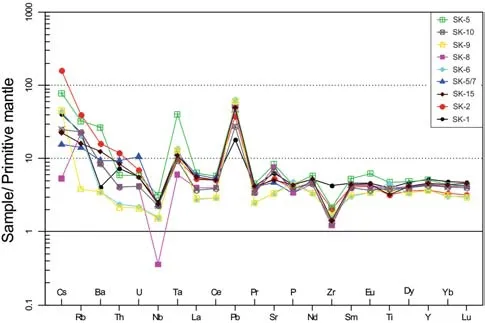
Fig.5 Primitive mantle normalized multi element diagram of meta basalts from the Sonakhan Greenstone Belt(Normalizing factors are from McDonough and Sun 1995)
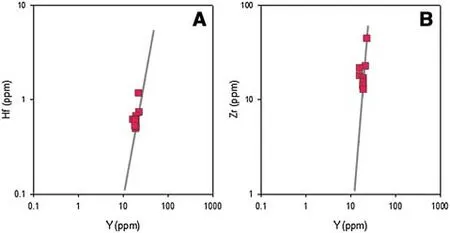
Fig.6 a Hf versus Y and b Zr versus Y diagrams indicating a linear geochemical trend for the meta basalts of SGB
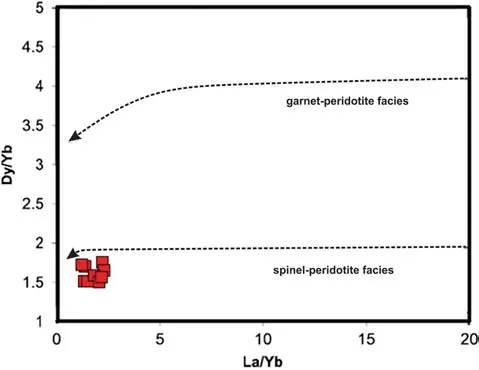
Fig.7 Dy/Yb versus La/Yb plot for the meta basalts from SGB indicating their generation at shallower depths in spinel-peridotite stability field(Jung et al.2006)

Fig.8 La/Yb versus Yb diagram showing model melting curves for non-model fractional melting of garnet and spinel lherzolite facies(Baker et al.1997).Numbers on the curves represent the percentage of melting of model mantle
Variousdifferentiation processes have to be evaluated in detail for finding out the reason for magma modification.In the present case,fractional crystallization,which is the most important magma modification process,has been evaluated with the help of trace elements.In the La/Sm-La diagram,data points plot along a nearly horizontal line(Fig.9),indicating that fractional crystallization(Allegre and Minster 1978)has played a vital role in the modification of magma.Thepositiverelationship between Ni and Mg#(Fig.10a)indicates fractional crystallization of olivine minerals(Wilson 1989).Sc iscompatible in pyroxene but not in olivine(Rollinson 1993),and the positive correlation of Sc with Mg#indicate pyroxene fractionation(Fig.10b).
To evaluate the role of fractional crystallization,Rayleigh’s fractional crystallization model was used.The sample SK-6 exhibits the minimum values for REE(ΣREE=21.85 ppm),and it was considered as representative of the least fractionated magma in the whole assemblage.In contrast,the sample SK-51 with highest REE(ΣREE=51.92 ppm)was considered as the final product of fractional crystallization.It is evident from the variation diagrams and chondrite normalized diagrams that olivine,clinopyroxene,and plagioclase were the governing phases in the fractional crystallization.As these rocks are of tholeiite nature,it can be assumed that olivine governed the crystal fractionation to a lesser degree than clinopyroxene and plagioclase.For fractional crystallization modeling,the fractionating minerals considered were plagioclase,clinopyroxene olivine,magnetite,and ilmenite.Modeling with REE revealed that the most evolved samples represented the product of fractional crystallization of SK-6 with 35%plagioclase,35%clinopyroxene,20%olivine,5%magnetite and 5%ilmenite as fractionating minerals with 40%residual liquid(Fig.11).
5.3 Geodynamic setting of SGB

Fig.9 La/Sm versus La Plots of SGB in a nearly horizontal line,indicating importance of fractional crystallization
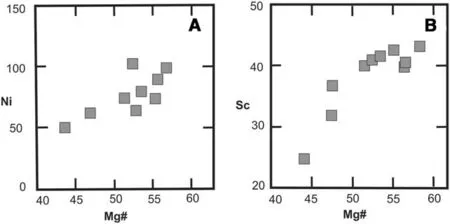
Fig.10 Mg#values of SGB samples plotted against a Ni and b Sc
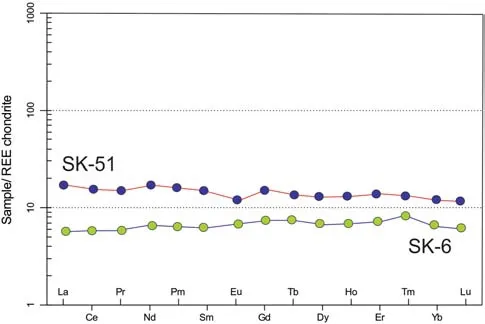
Fig.11 REE modeling results for fractional crystallization
During subduction,Ti becomes depleted in the source,whereas V is enriched in the source magma.As the oxidation increases due to subduction-derived fluids,vanadium becomes more incompatible than in the lower oxidation state.Thus,higher Ti/V ratio indicates a subduction influenced source region(Shervais1982).From Ti-V diagram(Fig.12)it wasobserved that all samplesexcept two were characterized by island arc setting.Scattering of thesamplesmay be dueto thevaried metasomatic effect or other post-magmatic alterations.

Fig.12 V versus Ti tectonic discrimination diagram(Shervais1982)of mafic metavolcanics of Sonakhan Greenstone Belt
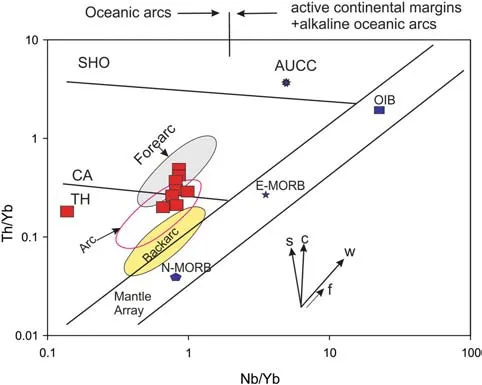
Fig.13 Plot of Th/Yb versus Nb/Yb for metabasaltic rocksof SGB.The mantle array includes constructive plate boundary magmas(NMORB normal mid-ocean ridge basalts,E-MORB enriched mid ocean ridge basalts)and within-plate alkaline basalts(OIB ocean island basalts).AUCC is Archean upper continental crust.Fields for convergent margin basalts include the tholeiitic(TH),calc-alkaline(CA),and shoshonitic(SHO)magmaseries.The vectors S,C,W,and f refer to subduction zone component,crustal contamination,within plate fractionation,and fractional crystallization respectively(after Pearce2008).Forearc,arc,and backarc fieldsareof recent convergent margins fields are from Metcalf and Shervais(2008)
The classification scheme proposed by Pearce(2008)was followed in the next step.According to Pearce(2008),if the mantle arrays were modified by subduction-derived fluids,it would be enriched in Th.As a result,the Th/Yb ratio would be higher in subduction-related components than that of the mantle array.The basaltic rocks in the present area,when plotted in the Th/Yb versus Nb/Yb diagram(Fig.13),fall in the volcanic arc array with arcfore arc signatures.For further confirmation on the subduction-related genesis of SGB,we carried out the geochemical screening method proposed by Condie(1989).The average values of basaltic rocks from the terrane were compared with four screens,and it wasfound that therocks were characterized by subduction-related genesis(Table 2).The elemental ratios of Nb/La(0.455467),Ti/Y(252.3778),in first order of SCREEN 1 and Ti/V(20.56667),TiO2(0.778889),Ta(0.525667)and Nb(1.350889)values in the second order of SCREEN 1 clearly exhibited the arc basalt tectonic setting for the SGB.Hf/Th(0.953691)and Ce/Nb(5.53783)ratios indicated N-MORB in SCREEN 2.From SCREEN 3 the values of Th/Yb(0.283615),Th/Nb(0.45622),Nb/La(0.455467)exhibited arc basalt characteristics.In SCREEN 4,Zr/Y(0.924893)and Ta/Yb(0.030336)exhibited IAB-CABI character.IAB tectonic framework of the metabasalts from SGB was confirmed with Th/Yb(0.283615)and Ti/Zr(322.0413)ratios from SCREEN 5.Figure 14 depicts a flow chart illustrating different screening methods marked with the behavior of SGB metabasalts on each screen.The chemical composition of subduction zone magmas generated in theconvergent boundarieswasmainly controlled by two sources:the mantle wedge and the slab components(i.e.,fluids and/or melts generated from the subducting slab)(Tatsumi et al.1986;Morris et al.1990;Hawkesworth et al.1993;Pearce and Peate 1995;Pearce 2008).

Table 2 Geochemical screening of meta basalts of SGB(after Condie 1989)
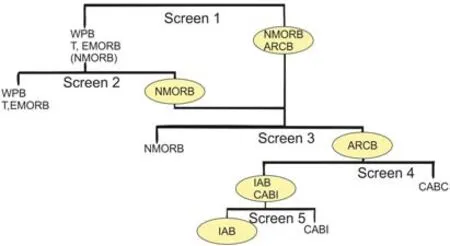
Fig.14 Flow chart depicting tectonic classification of mafic metavolcanics from Sonakhan Greenstone Belt(Condie 1989)
Deshmukh et al.(2017)proposed a subduction-related genesis for the felsic metavolcanic rocks of Bagmara formation of SGB.Prominent negative Nb anomaly in the multi-element spider diagram,along with other elemental fingerprints,clearly indicated subduction magmatism(Keleman et al.2004;Pearce,2008;Perfit et al.1980;Tatsumiet al.1986;Pearceand Stern2006;Hawkesworth et al.1993;Pearce and Peate 1995).In an arc-related environment,the subducted slab underwent dehydration during the initial stageof subduction.The subducting slab dehydrated,and the subduction-derived fluids caused themetasomatism of the mantle wedge.However,the differences in the melting process in a subduction-related environment were primarily due to the difference in PH2O(Manning 2004;Mibe et al.2011;Anderson et al.1980)Thehigher PH2Oin an arc-related environment incorporated LILE and LREE into the melt phase and as a result,the residual mantle became enriched in HFSE.Depletion of HFSE with reference to the LILE and LREE/HFSE ratios and Nb,Zr anomalies,which were perceptible in the mafic rocks of SGB,were characteristic features of Island arc magmas(Fig.5)(Pearce2008;Manning 2004;Wilson and Davidson 1984).The enrichment in LILE indicated that the SGB metabasalts were derived as a result of metasomatism of the depleted mantle wedge beneath the Bastar Craton.The Archean geothermal gradient,size and dynamics of plates collectively played a significant role in the generation of these basaltic rocks.Various studies at Archean greenstone terrane imply that the Neoarchean convergent margins,wedge melting,arc magmatism and slab dehydration were the prominent mechanisms involved in the generation of arc basaltic magma(Wyman 2003;Kerrich et al.1998,Wyman and Kerrich 2009;Lafleche et al.1992).
AcknowledgementsSDD expresses his sincere thanks to Dr.S.K.Rajput,Principal,Govt.V.Y.T.PG Autonomous College,Durg.The authors are also thankful to Dr.Sandeep Vansutre and Dr.Shailesh Agrawal for their help in the preparation of the manuscript.Financial support from UGC to S.D.Deshmukh is gratefully acknowledged.
Allegre CJ,Minster JF(1978)Quantitative models of trace element behavior in magmatic processes.Earth Planet Sci Lett 38(1):1–25
Anderson RN,Stephen ED,Schwarz WM(1980)Dehydration,asthenospheric convection and seismicity in subduction zones.JGeol 88:445–451
Arndt NT (1994)Archean komatiites.Dev Precambrian Geol 11:11–44
Arndt NT,Goldstein SL(1989)An open boundary between lower continental crust and mantle:its role in crust formation and crustal recycling.Tectonophysics 161(3):201–212
Arth JG,Hanson GN(1975)Geochemistry and origin of the early Precambrian crust of northeastern Minnesota.Geochim Cosmochim Acta 39(3):325–362
Baker JA,Menzies MA,Thirlwall MF,MacPherso CG(1997)Petrogenesis of Quaternary intraplate volcanism,Sana’a,Yemen:implications for plume–lithosphere interaction and polybaric melt hybridization.JPetrol 38(10):1359–1390
Balasubramanyan MN(2006)Geology and tectonics of India:an overview.International Association of Gondwana Research,Kochi,Japan,p 206
Boynton WV(1984)Cosmochemistry of the rare earth elements;meteorite studies.In:Henderson P(ed)Rare earth element geochemistry.Elsevier Sci.Publ.Co.,Amsterdam,pp 63–114
Condie KC(1989)Geochemical changes in basalts and andesites across the Archean Proterozoic boundary:identification and significance.Lithos 23:1–18
Condie KC,Harrison NM(1976)Geochemistry of the archean Bulawayan group,Midlands Greenstone Belt,Rhodesia.Precambrian Res 3(3):253–271
Das N,Royburman K,Vatsa US,Mahurkar VY(1990)Sonakhan Schist Belt,a Precambrian granite—greenstone complex.Geol Surv India Spec Publ 28:118–132
Deshmukh SD,Hari KR,Diwan P(2006)Pillow Lavas of Baghmara Formation(Sonakhan Greenstone Belt),Central India:geochemical constraints from major elements.Gond Geol Mag 21(1):37–42
Deshmukh SD,Hari KR,Diwan P,Basavarajappa HT(2008)Spinifex textured metabasalt from Sonakhan Greenstone Belt,Central India.Indian Miner 42:71–83
Deshmukh SD,Hari KR,Diwan P,Manu Prasanth MP(2017)Geochemistry and petrogenesis of felsic meta-volcanic rocks of Baghmara Formation,Sonakhan Greenstone Belt,Central India.JGeosci Res 2(1):69–74
Floyd PA,Winchester JA(1975)Magma type and tectonic setting discrimination using immobile elements.Earth Planet Sci Lett 27:211–218
Foley S,Tiepolo M,Vannucci R(2002)Growth and early continental crust controlled by melting of amphibolite in subduction zones.Nature 417:837–840
Furnes H,De Wit M,Dilek Y(2014)Four billion years of ophiolites reveal secular trends in oceanic crust formation.Geosci Front 5(4):571–603
Furnes H,Dilek Y,De Wit M(2015)Precambrian greenstone sequences represent different ophiolite types.Gondwana Res 27(2):649–685
Ghosh S,Rajajaiya V,Ashiya ID(1995)Rb-Sr dating of components from the Sonakhan Granite-Greenstonebelt,Raipur District.MP Rec Geolo Surv India 128:11–13
Hawkesworth CJ,Gallagher K,Hergt JM(1993)Mantle and slab contributions in arc magmas.Annu Rev Earth Planet Sci 21:175–204
Hawkesworth CJ,Dhuime B,Pietranik AB,Cawood PA,Kemp AI,Storey CD (2010)The generation and evolution of the continental crust.JGeol Soc 167:229–248
Jung C,Jung S,Hoffer E,Berndt J(2006)Petrogenesis of Tertiary mafic alkaline magmas in the Hocheifel,Germany.J Petrol 47(8):1637–1671
Keleman PB,Hanghoj K,Greene AR(2004)One view of the geochemistry of subduction-related magmatic arcs with an emphasis on primitive andesite and lower crust.In:Holland HD,Turekian KK(eds)Treatise on geochemistry 3.Elsevier,Amsterdam,pp 593–659
Kerrich R,Wyman DA,Fan J,Bleeker W(1998)Boninite series:low Ti-tholeiite associations from the 2.7 Ga Abitibi Greenstone Belt.Earth Planet Sci Lett 164:303–316
Kröner A,Hoffmann JE,Xie H,Wu F,Münker C,Hegner E,Wong J,Wan Y,Liu D(2013)Generation of early Archaean felsic greenstonevolcanic rocksthroughcrustal meltingin the Kaapvaal craton,southern Africa.Earth Planet Sci Lett 381:188–197
Lafleche MR,Dupuy C,Dostal J(1992)Tholeiitic volcanic rocks of the late Archaean Blake River group,southern Abitibi Greenstone Belt:origin and geodynamic implications.Can JEarth Sci 29:1448–1458
Le Bas MJ,Streckeisen AL(1991)The IUGSsystematics of igneous rocks.JGeol Soc Lond 148:825–833
Le Bas MJ,Lemaitre RW,Streckeisen A,Zanettin B(1986)A chemical classification of volcanic-rocksbased on thetotal alkali silica diagram.JPetrol 27(3):745–750
Ludden J,Gélinas L,Trudel P(1982)Archean metavolcanics from the Rouyn-Noranda district,Abitibi Greenstone Belt,Quebec.2.Mobility of trace elements and petrogenetic constraints.Can J Earth Sci 19(12):2276–2287
MacGeehan PJ,MacLean WH(1980)An Archaean sub-seafloor geothermal system,calc-alkali’trends,and massive sulphide genesis.Nature 286:767–771
Manning CE(2004)The chemistry of subduction-zone fluids.Earth Planet Sci Lett 223:1–16
McDonough WF,Sun SS(1995)Composition of the earth.Chem Geol 120:223–253.doi:10.1016/0009-2541(94)00140-4
Metcalf RV,Shervais JW(2008)Suprasubduction-zone ophiolites:Is there really an ophiolite conundrum?Geol Soc Am Spec Pap 438:191–222
Mibe K,Kawamoto T,Matsugake KN,Fei Y,Ono S(2011)Slab melting versus slab dehydration in subduction-zone magmatism.PNAS.doi:10.1073/pnas.1010968108/-/DCSupplemental
Morris JD,Leeman WP,Tera F(1990)The subducted component in island arc lavas:constraints from Be isotopes and B-Be systematics.Nature 344:31–36
Mottl MJ(1983)Metabasalts,axial hot springs,and the structure of hydrothermal systems at mid-ocean ridges.Geol Soc Am Bull 94(2):161–180
Naqvi SM(2005)Geology and evolution of the Indian plate.Capital Publishing,New Delhi,p 450
Naqvi SM,Rogers JJW(1987)Precambrian geology of India.Oxford University Press,Oxford,p 223
Pearce JA(1982)Trace element characteristics of lavas from destructive plate boundaries.In:Thorpe RS(ed)Andesites.Wiley,Chidester,pp 525–548
Pearce JA(2008)Geochemical fingerprinting of oceanic basalts with applications to ophiolite classification and the search for Archean oceanic crust.Lithos 100:14–48
Pearce JA(2014)Immobile element fingerprinting of ophiolites.Elements 10(2):101–108
Pearce JA,Peate DW(1995)Tectonic implications of the composition of volcanic arc magmas.Annu Revi Earth Planet Sci 23:251–285
Pearce JA,Stern RJ(2006)Origin of back-arc basin magmas:trace element and isotope perspectives.Back-arc spreading systems:geological,biological,chemical and physical interactions.Geophys Monogr Ser 166:66–86
Perfit MR,Gust DA,Bence AE,Arculus RJ,Taylor SR(1980)Chemical characteristics of island-arc basalts:implications for mantle sources.Chem Geol 30(3):227–256
Polat A(2013)Geochemical variations in Archean volcanic rocks,southwestern Greenland:traces of diversetectonic settings in the early Earth.Geology 41(3):379–380
Polat A,Hofmann AW,Rosing Minik Thorleif(2002)Boninite-like volcanic rocks in the 3.7–3.8 Ga Isua Greenstone Belt,West Greenland:geochemical evidence for intra-oceanic subduction zone processes in the early Earth.Chem Geol 184(3):231–254
Radhakrishna BP(1976)Two greenstone groups in Dharwar Craton.Ind Miner 16:12–15
Radhakrishna BP,Ramakrishnan M(1988)Archaean-Proterozoic boundary in India.JGeol Soc Ind 32:263–278
Radhakrishna BP,Ramakrishnan M(eds)(1990)Archaean Greenstone Belts of South India.Geological Society of India,Mem.19:497
Rajamani V,Shivkumar K,Hanson GN,Shirey AS(1985)Geochemistry and petrogenesis of amphibolites,Kolar Schist Belt,South India:evidence for komatiitic magma derived by low percentages of melting of the mantle.JPetrol 26(1):92–123
Ramakrishnan M,Vaidyanadhan R(2008)Geology of India,vol 1.Geological Society of India,p 994
Ramchandra HM,Roy A,Mishra VP,Dutta NK(2001)A critical review of the tectonothermal evolution of the Bastar Craton.MS Krishnan Cent Comm Nat Sem Geol Surv Ind Spec Publ 55:161–180
Rapp R,Shimizu N,Norman MD(2003)Growth of early continental crust by partial melting of eclogite.Nature 425:605–609
Ray RK,Rai KL(2004)Geological setting and petrogenesis of the auriferous metavolcanic complex of Sonakhan,Raipur district,Chhattisgarh.SAAEG JEcol Geol 1:45–60
Ray RK,Pandey HK,Rai KL(2000)Geochemistry of Mafic volcanics associated with sulphide mineralization in Sonakhan,Raipur district,Madhya Pradesh.In:Gyani KC,Kataria P(eds)Proc nat Sem on‘Tectonomagmatism,Geochemistry and Metamorphism of Precambrian terrain.’Univ Dept of Geology Udaipur,pp 381–393
Rogers JJW,Santosh M(2003)Supercontinents in earth history.Gondwana Res 6:357–368
Rollinson HR(1993)A terrane interpretation of the Archaean Limpopo Belt.Geol Mag 130(06):755–765
Rollinson H(1999)Petrology and geochemistry of metamorphosed komatiites and basaltsfrom the Sula Mountains Greenstone Belt,Sierra Leone.Contrib Miner Petrol 134(1):86–101
Sajona FG,Maury RC,Bellon H,Cotten J,Defant M(1996)High field strength element enrichment of Pliocene—Pleistocene Island Arc Basalts,Zamboanga Peninsula,Western Mindanao(Philippines).JPetrol 37(3):693–726
Shervais JW(1982)Ti–V plots and the petrogenesis of modern and ophiolitic lavas.Earth Planet Sci Lett 32:114–120
Tatsumi Y,Hamilton DL,Nesbitt RW(1986)Chemical characteristics of fluid phase from the subducted lithosphere:evidence from high-pressure experiments and natural rocks.J Volcanol Geother Res 29:293–309
Venkatesh AS(2001)Geochemical signatures and auriferous implications in Sonakhan Greenstone Belt,Chhattisgarh.Geol Surv India Spec Publ 55:219–228
Wilson M(1989)Igneous petrogenesis:a global tectonic approach.Unwyn Hyman,London
Wilson M,Davidson JP(1984)The relative roles of crust and upper mantle in the generation of oceanic island-arc magmas.Philos Trans R Soc Lond A 310:661–674
Wyman DA(2003)Upper mantle processes beneath the 2.7 Ga Abitibi belt,Canada:a trace element perspective.Precambrian Res 127:143–165
Wyman DA,Kerrich R(2009)Plume and arc magmatism in the Abitibi subprovince:implications for the origin of Archean continental lithospheric mantle.Precambrian Res 168:4–22
Xiao WJ,Santosh M(2014)The western Central Asian Orogenic Belt:a window to accretionary orogenesis and continental growth.Gond Res 25:1429–1444.doi:10.1016/j.gr.2014.01.008
Xie Q,Kerrich R,Fan J(1993)HFSE/REE fractionations recorded in three komatiite-basalt sequences,Archean Abitibi Greenstone Belt:implications for multiple plume sources and depths.Geochim Cosmochim Acta 57(16):4111–4118
Yedekar DB,Jain SC,Nair KKK,Dutta KK(1990)Central Indian collision suture.Geol Surv Ind Spec Publ 29:1–43
Yedekar DB,Karmalkar N,Pawar NJ,Jain SC(2003)Tectonomagmatic evolution of central Indian terrain.Gond Geol Mag Spec 7:67–68
Zhai MG(2014)Multi-stage crustal growth and cratonization of the North China Craton.Geosci Front.doi:10.1016/j.gsf.2014.01.003
- Acta Geochimica的其它文章
- A hydrochemical approach to estimate mountain front recharge in an aquifer system in Tamilnadu,India
- Source and yearly distribution of PAHs in the snow from the Hailuogou glacier of Mountain Gongga,China
- Zircon SHRIMP U–Pb age of Late Jurassic OIB-type volcanic rocks from the Tethyan Himalaya:constraints on the initial activity time of the Kerguelen mantle plume
- Oil geochemistry derived from the Qinjiatun–Qikeshu oilfields:insight from light hydrocarbons
- Organic carbon content and carbon isotope variations across the Permo-Triassic boundary in the Gartnerkofel-1 borehole,Carnic Alps,Austria
- U–Pb zircon age of the base of the Ediacaran System at the southern margin of the Qinling Orogen

